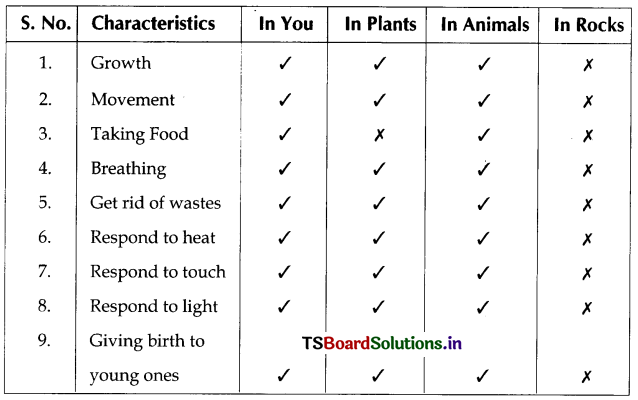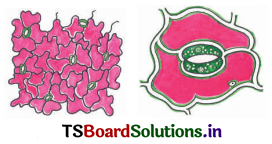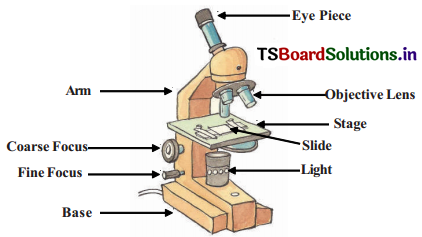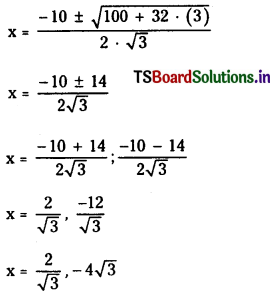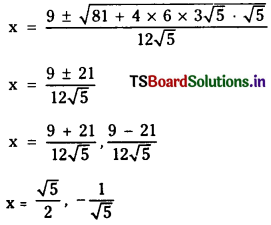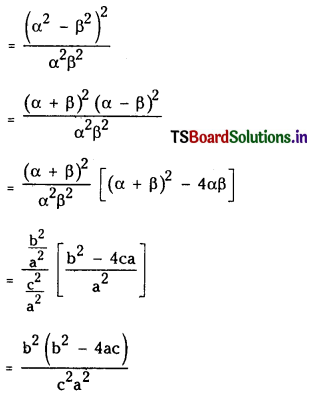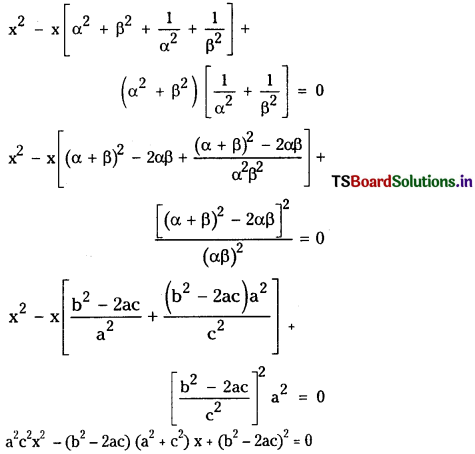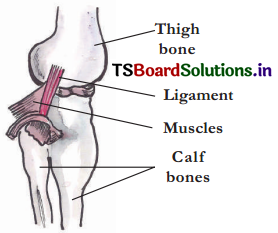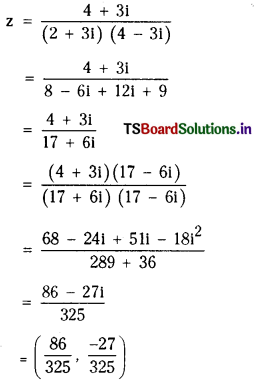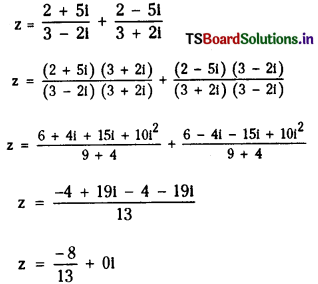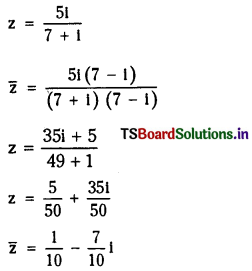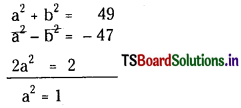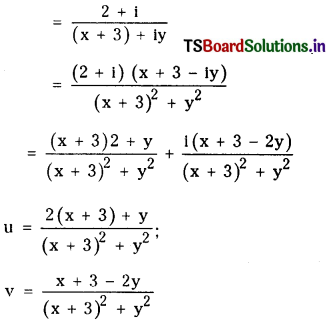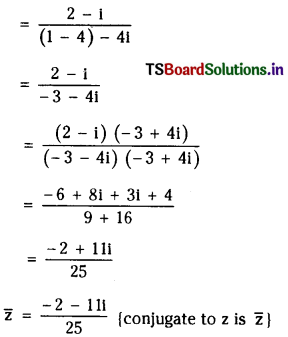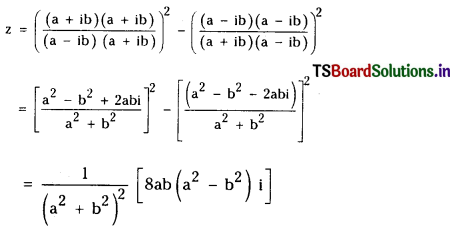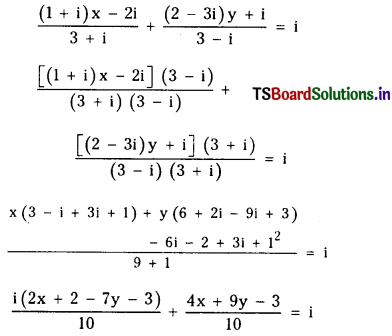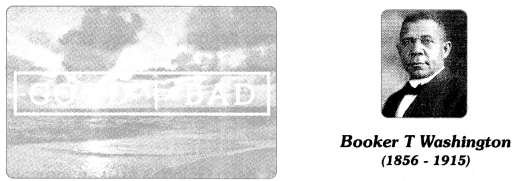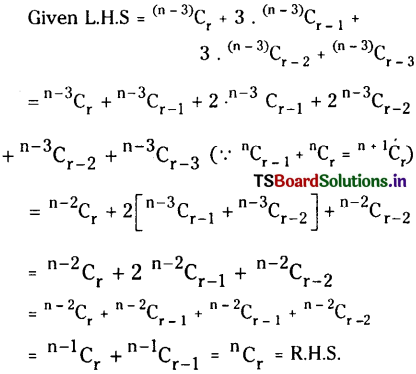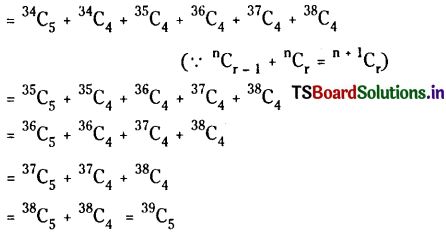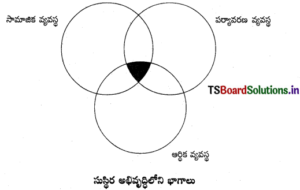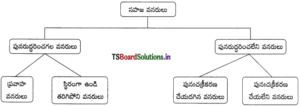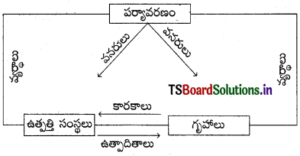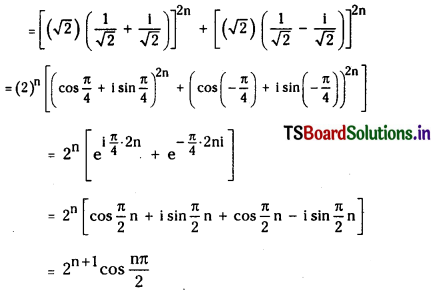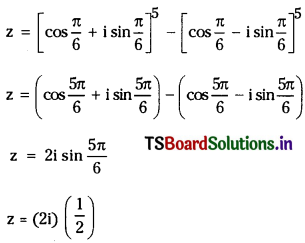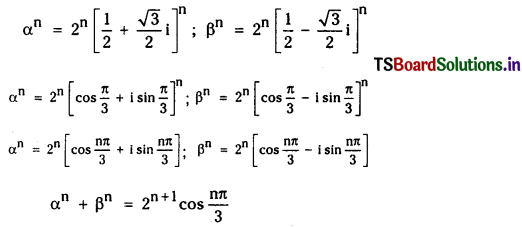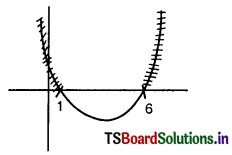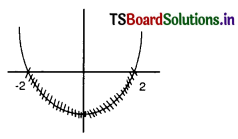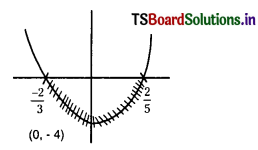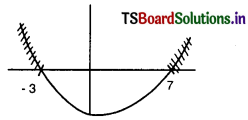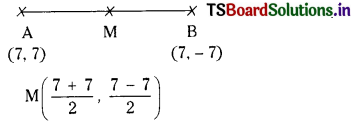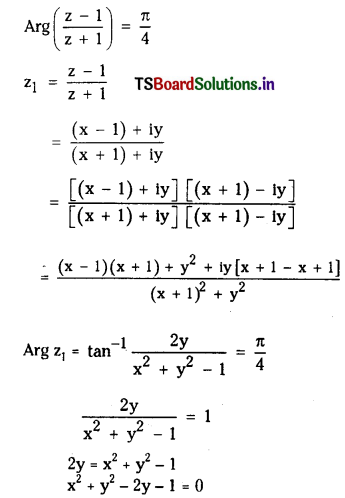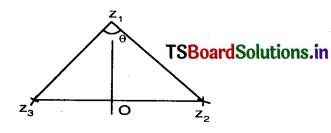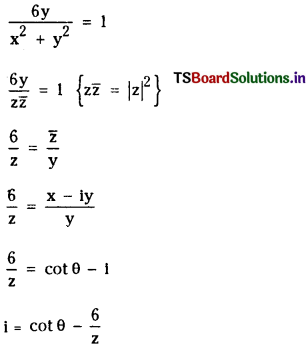Students must practice this TS Intermediate Maths 2A Solutions Chapter 5 Permutations and Combinations Ex 5(a) to find a better approach to solving the problems.
TS Inter 2nd Year Maths 2A Solutions Chapter 5 Permutations and Combinations Ex 5(a)
I.
Question 1.
If \({ }^{\mathrm{n}} \mathrm{P}_3\) = 1320, find n.
Solution:
Given \({ }^{\mathrm{n}} \mathrm{P}_3\) = 1320
⇒ n(n – 1) (n – 2) = 12 × 11 × 10
On comparing, we have n = 12.
Question 2.
If \({ }^n P_7\) = 42 P5, find n.
Solution:
Given \({ }^n P_7\) = 42 . \({ }^n P_5\)
⇒ \(\frac{n !}{(n-7) !}=42 \cdot \frac{n !}{(n-5) !}\)
⇒ \(\frac{n !}{(n-7) !}=42 \cdot \frac{n !}{(n-5)(n-6)(n-7) !}\)
⇒ (n – 5) (n – 6) – 42
⇒ (n – 5) (n – 6) = 7 × 6
On comparing largest integers, we have n – 5 = 7
⇒ n = 12.
Question 3.
If \({ }^{(n+1)} P_5:{ }^n P_6\) = 2 : 7, find n.
Solution:
Given \({ }^{(n+1)} P_5:{ }^n P_6\) = 2 : 7
⇒ \(\frac{(n+1) !}{(n-4) !}: \frac{n !}{(n-6) !}\) = 2 : 7
⇒ \(7 \cdot \frac{(n+1) !}{(n-4) !}=2 \cdot \frac{n !}{(n-6) !}\)
⇒ \(\frac{7 \cdot(n+1) \cdot n !}{(n-4)(n-5)(n-6) !}=2 \cdot \frac{n !}{(n-6) !}\)
⇒ 7(n + 1) = 2 (n – 4) (n – 5)
⇒ 2n2 – 25n + 33 = 0
⇒ (2n – 3) (n – 11) = 0
(∵ 2n – 3 ≠ 0 as an integer)
⇒ n – 11 = 0
⇒ n = 11.
![]()
Question 4.
If \({ }^{12} P_5+5 \cdot{ }^{12} P_4={ }^{13} P_t\) find r.
Solution:
Given, \({ }^{12} P_5+5 \cdot{ }^{12} P_4={ }^{13} P_t\)

Alternate method:
We know that
\({ }^n P_r={ }^{(n-1)} P_r+r \cdot{ }^{(n-1)} P_{r-1}\)
∴ \({ }^{12} \mathrm{P}_5+5 \cdot{ }^{12} \mathrm{P}_4={ }^{13} \mathrm{P}_{\mathrm{r}}\)
\({ }^{13} P_5={ }^{13} P_r\)
∴ r = 5.
Question 5.
If \({ }^{18} P_{(r-1)}{ }^{17} P_{(r-1)}\) = 9 : 7, find r.
Solution:
Given \({ }^{18} P_{(r-1)}{ }^{17} P_{(r-1)}\) = 9 : 7
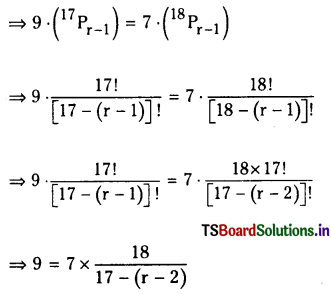
19 – r = 14
r = 5.
Question 6.
A man has 4 sons and there are 5 schools within his reach. In how many ways can he admit his sons In the schools so that no two of them will he in the same school.
Solution:
The first son can be admitted to any one of the 5 schools ¡n 5 ways.
The second son can be admitted to any one of the remaining 4 schools in 4 ways.
Proceeding like this, the number of ways can he admit his sons in the schools so that no two of them will be in same school = 5 × 4 × 3 × 2 = \({ }^5 \mathrm{P}_4\) (or) 120.
![]()
II.
Question 1.
If there are 25 railway stations on a railway line, how many types of single second class tickets must be printed, so as to enable a passenger to travel from one station to another.
Solution:
Let the ticket printed to enable a passenger to travel be from station ‘x’ to station ‘y’.
As there are 25 railway stations on a railway line, ‘x’ can be filled in 25 ways and ‘y’ can be filled in remaining 24 ways.
∴ The required number of tickets = 25 × 24
= \({ }^{25} \mathrm{P}_2\) or 600.
Question 2.
In a class there are 30 students. On the New year day, every student posts a greeting card to all his/her classmates. Find the total number of greeting cards posted by them.
Solution:
Number of students in a class = 30.
As every student posts a greeting card to all his/her classmates,
the total number of greeting cards = \({ }^{30} \mathrm{P}_2\) = 870.
Question 3.
Find the number of ways of arranging the letters of the word TRIANGLE so that the relative positions of the vowels and conso-nants are not disturbed.
Solution:
The given word TRIANGLE has 3 vowels and 5 consonants.
Since the relative positions of vowels and consonants are not to be disturbed.
3 vowels can be arranged in their relative positions in 3! ways.
Similarly, 5 consonants can be arranged in their relative position in 5! ways.
∴ By fundamental principle of counting, the required number of ways = 3! × 5! = 720.
![]()
Question 4.
Find the sum of all 4 digited numbers that can be formed using the digits 0, 2, 4, 7, 8, without repetition.
Solution:
Given digits are 0, 2, 4, 7, 8.
For a four digit number formed from given digits without repetition,
Thousand’s place can be filled by non-zero digit in 4 ways,
Hundred’s place can be filled by remaining 4 digits in 4 ways,
Ten’s place can be filled in 3 ways and units place can be filled in 2 ways.
∴ By fundamental principle of counting, the number of four digited numbers formed = 4 × 4 × 3 × 2 = 96
Out of these 96 numbers,
the numbers with ‘2’ in units place are 3 × 3 × 2 = 18
Similarly the numbers with ’2’ in ten s place are 18.
The numbers with ‘2’ in Hundred’s place are = 18.
The numberlrwith ‘2’ in thousands place are \({ }^4 \mathrm{P}_3\) = 24.
∴ The value obtained by adding ‘2’ in all the numbers = 18 (2) + 18 (20) + 18 (200) + 24 (2000)
= 18 × 2 (111) + 24 × 2 × 1000
Similarly the value obtained by adding ‘4’ is 18 × 4 (111) + 24 × 4 × 1000
The value obtained by adding ‘7’ is 18 (7) (111) + 24 × 7 × 1000
The value obtained by adding ‘8’ is 18 × 8 × 111 + 24 × 8 × 1000
∴ The sum of all numbers = 18 × 2 × 111 + 24 × 2 × 1000 + 18 × 4 × 111 + 24 × 4 × 1000 + 18 × 7 × 111 + 24 × 7 × 1000 + 18 × 8 × 111 + 24 × 8 × 1000
= 18 × 111 × (2 + 4 + 7 + 8) + 24 × 1000 × (2 + 4 + 7 + 8)
= 18 × 111 × 21 + 24 × 1000 × 21
= 3 × 6 × 111 × 21 +4 × 6 × 1000 × 21
= 21 × 6 (333 + 4000)
= 21 × 6 (4333) = 5,45,958.
Question 5.
Find the number of numbers that are greater than 4000 which can be formed using the digits 0, 2, 4, 6, 8 without repetition.
Solution:
Given digits are 0, 2, 4, 6, 8.
All the five digit numbers are greater than 4000.
In the case of four digit numbers, the numbers which start with 4 or 6 or 8 are greater than 4000.
The number of 4 digit numbers which starts with 4 or 6 or 8 using the given digits with out repetition are 3 × \({ }^4 P_3\) = 3 × 24 = 72.
The number of 5 digit numbers using the given digits with out repetition are 4 × 4! = 4 × 24 = 96
∴ The number of numbers which are greater than 4000 are 72 + 96 = 168.
Question 6.
Find the number of ways of arranging the letters of the word MONDAY so that no vowel occupies even place.
Solution:
Given word is MONDAY
Given word contains 2 vowels and 4 conso-nants.
Also given word contains 3 odd places and 3 even places.
. Since no vowel occupies even places, the two vowels in three odd places can be filled in \({ }^3 \mathrm{P}_2\) ways.
The four consonants can be filled in remain-ing four places in 4! ways.
∴ By fundamental principle of counting the required numbers of ways = \({ }^3 \mathrm{P}_2\) × 4! = 144.
![]()
Question 7.
Find the number of ways of arranging 5 different mathematics books, 4 different physics books and 3 different chemistry books such that the books of the same subject are together.
Solution:
Given number of Mathematics books = 5
Given number of Physics books = 4
Given number of Chemistry books = 3
Treat all Mathematics books as 1 unit, Phys¬ics books as 1 unit, Chemistry books as 1 unit.
The number of ways of arranging 3 units of books = 3!
5 different Mathematics books can be arranged in 5! ways.
4 different Physics books can be arranged in 4!
3 different Chemistry books can be arranged in 3! ways.
∴. By fundamental principle of counting, required number of ways of arranging books = 3! × 5! × 4! × 3!
= 6 × 120 × 24 × 6 = 1,03,680.
III.
Question 1.
Find the number of 5 letter words that can be formed using the letter of the word CONSIDER. How many of them begin with “C”, how many of them end with “R”, and how many of them begin with “C” and end with “R” ?
Solution:
Given word “CONSIDER” contains 8 different letters.
The number of 5 letter words that can be formed using the letters of word CONSIDER = \({ }^8 \mathrm{P}_5\)
Out of them,
i) If first place is filled by ‘C’, the remaining 4 places by remaining 7 letters can be filled in \({ }^7 \mathrm{P}_4\) ways.
Number of words begin which ‘C’ are P4.
ii) if last place is filled by ’R’, the remaining first four places by remaining 7 letters can be filled in \({ }^7 \mathrm{P}_4\) ways.
/. Number of words end with ’R’ are \({ }^7 \mathrm{P}_4\).
iii) If first place is filled with ‘C’ and last place is filled by ‘R’, the remaining 3 places between them by remaining 6 letters can be filled in \({ }^6 \mathrm{P}_3\) ways.
∴ Number of words begin with ‘C’ and end with ‘R’ are \({ }^6 \mathrm{P}_3\).
Question 2.
Find the number of ways of seating 10 students A1, A2, ………….., A10 in a row such that
i) A1, A2, A3 sit together
ii) A1, A2, A3 sit in a specified order.
iii) A1, A2, A3 sit together in a specified order.
Solution:
A1, A2, ……………., A10 are the 10 students.
i) A1, A2, A3 sit together :
Treat A1, A2, A3 as 1 unit.
This unit with remaining 7 students can be arranged in 8! ways.
The students A1, A2, A3 can be arranged in 3! ways.
∴ The number of ways of seating 10 students such that A1, A2, A3 sit together = 8! × 3!.
ii) A1, A2, A3 sit in a specified order :
In 10 positions remaining 7 students other than A1, A2, A3 can be arranged in \({ }^{10} \mathrm{P}_7\)ways.
As A1, A2, A3 sit in a specified order, they can be arranged in 3 gaps in only 1 way.
∴ The number of ways of A1, A2, A2 sit in a 10 specified order = \({ }^{10} \mathrm{P}_7\).
iii) A1, A2, A3 sit together in a specified order :
Treat A1, A2, A3 as 1 unit and they are in a specified order.
This unit with remaining 7 students can be arranged in 8! ways.
∴ The number of ways of A1, A2, A3 sit to-gether in specified order = 8!.
![]()
Question 3.
Find the number of ways in which 5 red balls, 4 black balls of different sizes can be arranged in a row so that
(i) no two balls of the same colour come together
(ii) the balls of the same colour come together.
Solution:
Given 5 red balls and 4 black balls are of different sizes.
i) No two balls of same colour come to-gether :
First arrange 4 black balls in row, which can be done in 4! ways × B × B × B × B ×
Then we find 5 gaps, to arrange 5 red balls. This arrangement can be done in 5! ways.
∴ By principle of counting total number of ways of arranging = 5! × 4!.
ii) The balls of same colour come together:
Treat all red balls as one unit and all black balls as another unit.
The number of ways of arranging these two units = 2!
The 5 red balls can be arranged in 5! ways while 4 black balls are arranged in 4! ways.
By fundamental principal of counting, the required number of ways = 2! × 4! × 5!.
Question 4.
Find the number of 4 – digit numbers that can be formed using the digits 1, 2, 5, 6, 7. How many of them are divisible by
i) 2
ii) 3
iii) 4
iv) 5
v) 25
Solution:
The number of 4 digit numbers that can be formed using the digits 1, 2, 5, 6, 7 with out repetition are \({ }^5 \mathrm{P}_4\) or 120.
i) Divisible by 2 :
A number with an even digit in its units place is divisible by ‘2’.
This can be done in 2 ways (with 2 or 6). The remaining 3 places can be filled with the remaining 4 digits in \({ }^4 P_3\) ways.
∴ The number of 4 digit numbers, divisible by 2 are 2 × \({ }^4 P_3\) = 48.
ii) Divisible by 3 :
A number is divisible by 3 only when the sum of digits in that number is a multiple of 3.
Sum of given 5 – digits is 21.
The only way to select 4 digits using digits such that their sum is a multiple of 3 is selecting 1, 2, 5, 7.
We can arrange then in 4! ways.
∴ The number of 4 digit numbers which are divisible by 3 are 4! = 24.
iii) Divisible by 4 :
A number is divisible by 4 only when the number in last two places (i.e., ten’s and units) is a multiple of 4.
∴ The last two places should be filled with one of the following.
12, 16, 52, 56, 72, 76.
i.e., this can be done in 6 ways.
The remaining 2 places can be filled with remaining 3 digits in \({ }^3 \mathrm{P}_2\) ways.
∴ The number of 4 digit numbers which are divisible by 4 are 6 × \({ }^3 \mathrm{P}_2\)= 36.
iv) Divisible by 5 :
A number is divisible by 5, if the units place is 0 or 5.
Hence the units place from given digits is filled with ‘5’ only.
The remaining 3 places by remaining 4 digits can be filled in \({ }^4 \mathrm{P}_3\) ways.
The number of 4 digit numbers which are divisible by 5 are \({ }^4 \mathrm{P}_3\) = 24.
v) Divisible by 25 :
A 4 digit number formed by using given digits is divisible by 25 if the number formed by ten’s and unit’s places is either 25 or 75. This can be done in 2 ways.
Now the remaining 2 places with remaining 3 digits can be filled in \({ }^3 \mathrm{P}_2\) ways.
∴ The number of 4 digit numbers which are divisible by 25 are 2 × \({ }^3 \mathrm{P}_2\) = 12.
![]()
Question 5.
If the letters of the word MASTER are permuted in all possible ways and the words thus formed are arranged in the dictionary order, then find the ranks of the words
i) REMAST
ii) MASTER.
Solution:
Given word is MASTER.
∴ The alphabetical order of the letters is A, E, M, R, S, T.
In the dictionary order, first we write all words beginning with ‘A’.
Filling first place with ‘A’, the remaining 5 places can be filled with the remaining 5 letters in 5! ways.
∴ The number of words begin with ‘A’ are 5! on proceeding like this, we get.
i) Rank of the word REMAST :
The number of words begin with A is 5! = 120
The number of words begin with E is 5! = 120
The number of words begin with M is 5! = 120
The number of words begin with RA is 4! = 24
The number of words begin with REA is 3! = 6
The next word is REMAST.
∴ Rank of word REMAST = (120) 3 + 24 + 6 + 1 = 391.
ii) Rank of the word MASTER :
The number of words begin with A is 5! = 120
The number of words begin with E is 5! = 120
The number of words begin with MAE is 3! = 6
The number of words begin with MAR is 3! = 6
The number of words begin with MASE is 2! = 2
The number of words begin with MASR is 2! = 2
The next word is MASTER.
∴ Rank of word MASTER = 2 (120) + 2 (6) + 2 (2) + 1 = 257.
Question 6.
If the letters of the word BRING are per-muted in all possible ways and the words thus formed are arranged in the dictionary order, then find the 59th word.
Solution:
Given word is BRING.
∴ The alphabetical order of the letters is B, G, I, N, R.
In the dictionary order, first we write all words beginning with B.
Clearly the number of words beginning with B are 4! = 24.
Similarly the number of words begin with G are 4! = 24.
Since the words begin with B and G sum to 48, the 59th word must start with I.
Number of words given with IB = 3! = 6
Hence the 59th word must start with IG.
Number of words begin with 1GB = 2! = 2
Number of words begin with IGN = 2! = 2
∴ Next word is 59th = IGRBN.
![]()
Question 7.
Find the sum of all 4 digited numbers that can be formed using the digits 1, 2, 4, 5, 6 without repetition.
Solution:
Given digits are 1, 2, 4, 5, 6.
Hence the number of four digit numbers formed using given digits with out repetition are \({ }^5 P_4\) = 120.
Out of these 120 numbers the numbers with 2 in unit’s place = \({ }^4 P_3\)
the numbers with 2 in ten’s place = \({ }^4 P_3\)
the numbers with 2 in Hundred’s place = \({ }^4 P_3\)
The numbers with 2 in thousands place = \({ }^4 P_3\)
∴ The value obtained by adding ‘2’ in all-the numbers = \({ }^4 P_3\) × 2 + \({ }^4 P_3\) × 20 + \({ }^4 P_3\) × 200 + \({ }^4 P_3\) × 2000
= \({ }^4 P_3\) × 2 × 1111
Similarly the value obtained by adding T in all the numbers is \({ }^4 P_3\) × 1 × 1111
The value obtained by adding 4 in all the numbers is \({ }^4 P_3\) × 4 × 1111
The value obtained by adding 5 in all the numbers is \({ }^4 P_3\) × 5 × 1111
The value obtained by adding 6 in all the numbers is \({ }^4 P_3\) × 6 × 1111
.\ The sum of all the numbers = \({ }^4 P_3\) × 1 × 1111 + \({ }^4 P_3\) × 2 × 1111 + \({ }^4 P_3\) × 4 × 1111 + \({ }^4 P_3\) × 5 × 1111 + \({ }^4 P_3\) × 6 × 1111
= \({ }^4 P_3\) × (1111) (1 + 2 + 4 + 5 + 6)
= 24 × 1111 × 18 = 4,79,952
The sum of all 4 digit numbers that can be formed with given digits is 4,79, 952.
Question 8.
There are 9 objects and 9 boxes. Out of 9 objects, 5 cannot fit in three small boxes. How many arrangements can be made such that each object can be put in one box only.
Solution:
Given that there are 9 objects and 9 boxes.
As 5 objects out of 9, cannot fit in 3 small boxes, these 5 objects should be arranged in . remaining 6 boxes.
This can be done in \({ }^6 \mathrm{P}_5\) ways.
∴ The remaining 4 blanks are to be filled with remaining 4 objects.
This can be done in 4! ways.
∴ The required number of ways = \({ }^6 \mathrm{P}_5\) × 4! = 17,280.
